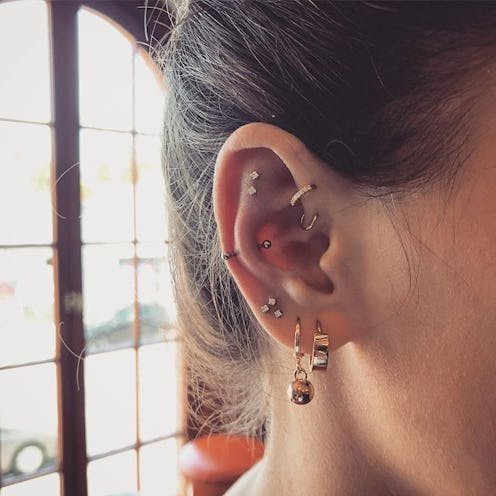If you’re looking for a unique way to express yourself (and an excuse to buy some cool jewelry), nothing’s better than getting a new piercing. Sure, it’s a more painful way to change up your look, but the adrenaline rush and opportunity to try different types of earrings puts it in a league of its own. And while classics like a lobe piercing, cartilage piercing, or an upper helix piercing never go out of style, it’s also worth considering a not-so-common placement to add to your collection: the snug piercing.
For the uninitiated: “A snug piercing goes through the outer rim of your ear to the inside of your ear on the way to your ear canal,” celebrity piercer and chief piercing officer of Body Electric Tattoo Brian Keith Thompson tells Bustle. It passes through an area called the anti-helix, also known as the stem of your ear — that sliver of cartilage in between ear canal and your outer cartilage. Because the piercing sits in the middle of other piercings you may have, like a tragus (a piercing on the piece of cartilage in front of your ear canal) or mid-helix piercing, it can bring together your other earrings and create a fun, cohesive look.
Thinking about getting a snug piercing but don’t know where to start? Read on for seven things experts say you absolutely need to know before, during, and after your appointment.
1Not Everyone Has The Anatomy For A Snug Piercing
First things first: Snug piercings aren’t for everyone. You need a specific ear shape to get your anti-helix pierced — and a lot of people don’t have it. “The ridge of the anti-helix needs to be super pronounced to support a piece of jewelry in that area,” piercer and owner of So Gold Studios Cassi Lopez-March tells Bustle. “Most people do not have the anatomy.”
2It Takes A Little Longer To Pierce Than Other Areas
A snug piercing can take a little longer than a lobe or other cartilage piercing due to its location on your ear. “A snug piercing is in a tight little spot, and getting our hands in there can be difficult,” Thompson says. “It’ll take around two seconds to complete.”
3It’s About As Painful As A Tragus Piercing
If you’ve gotten your tragus pierced (pictured above), Thompson says the sensation is “definitely similar” when your snug is pierced.
Pain isn’t something most people look forward to, but Thompson says it’s also part of the fun of getting a piercing, snug or otherwise. “The pain kind of makes it cool, he says. “ If it didn't hurt, it wouldn't be as special or as badass. You wouldn't have to muster up the courage or get butterflies in your stomach while you're filling out the paperwork.”
4Use A Foaming Soap To Clean Your Snug Piercing
When it comes to cleaning your piercing, a mild soap is the way to go. According to Thompson, “an odorless, colorless, hypoallergenic, mild face wash that lathers, not a hydrating soap.” A hydrating soap may require you to fiddle with your jewelry to get the lather you need to clean it, which could irritate your piercing and affect the healing process. A foaming soap, on the other hand, gets rid of all the dirt, oils, and buildup from the day with little to no maneuvering required.
“Just lightly glide the bubbles around the jewelry, and the entry and the exit of the piercing,” Thompson explains. “Then rinse it off with a shower head and make sure you get all the residue off. If you leave the soap on there, it could lead to dryness, and that can affect the healing process as well.”
Try this CeraVe Foaming Facial Cleanser. It’s formulated with ceramides, hyaluronic acid, and niacinamide to gently restore your skin barrier and calm skin.
5Be Careful Taking Off Your Mask
Irritating your snug piercing, by either playing around with it or moving it around to much while you’re cleaning it, is a major no no when you’ve just gotten the piercing. Thompson urges you to “leave your snug piercing alone” as much as possible. Which may get tricky when it comes to removing your mask.
“I’ve been seeing a lot of mask related issues lately,” Thompson says. “You inadvertently take your mask off and you catch [your snug piercing] in a certain way. That can be quite catastrophic. And if you keep doing it over and over again, you're gonna have healing issues due to trauma.”
When your putting your mask on or take it off, make sure you expand the string tie to avoid touching your ear and piercing as much as possible.
6It Takes A While To Heal
Prepare to be patient, and take good care of your piercing. Thompson says that healing can vary, but if you “follow all the rules” your piercer gives you regarding aftercare, avoid moving it around, and are conscious of the way you sleep (on your back or on your non-pierced side), it could take “three months to upwards of a year.”
Lopez-March says the average person can “expect a solid nine-plus months for your snug to heal.”
7Curved Barbells Are Usually The Way To Go
Both Thompson and Lopez-March favor a curved barbell on a snug piercing. “I just think it looks great,” Thompson says. “Plus, curved barbells are going to heal faster because there's going to be less movement.”
Lopez-March also mentions a “straight piece could also work when specific anatomy calls for it.”
